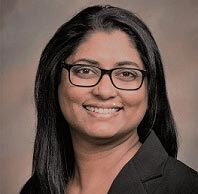Texas NP Practice Authority: How Texas NPs Can Fight the Rural Health Crisis
Find NP Schools
For the latest academic year, we have over 180 NP schools in our database and those that advertise with us are labeled “sponsor”. When you click on a sponsoring school or program, or fill out a form to request information from a sponsoring school, we may earn a commission. View our advertising disclosure for more details.
“My goal as faculty is to prepare my students to not just think clinically but systemically, where they can identify issues in the system and bring about change.”
Annie Abraham, DNP, Clinical Associate Professor, Baylor University Louise Herrington School of Nursing
Texas is home to the nation’s largest rural population: more than 3.6 million people. Yet it also faces some of the most severe rural health challenges in the US. More than half of the state’s rural hospitals are at risk of closure, and over 20 have already shuttered since 2010, leaving vast stretches of the state without essential services (Chartis 2025).
At the same time, rural communities face persistent shortages of primary care providers: the average patient-to-provider ratio in these areas is 2,632 to 1, compared with 1,981 to 1 in urban parts of the state (Concordia University). These challenges are compounded by Texas’s distinction as the state with the highest uninsured rate in the country, with more than one in five adults lacking health coverage.
NPs could be the answer to Texas’s rural healthcare problems. According to the US Bureau of Labor Statistics, there are approximately 21,690 NPs currently practicing throughout the state. As high-quality health providers, they’re expertly trained to provide high-quality care across the lifespan. And they can fill a critical gap, especially in rural settings: over 85 percent of NPs are trained in primary care, and they’re more likely than physicians to settle in rural areas.
Meet the Expert: Annie Abraham, DNP, APRN, FNP-BC

Dr. Annie Abraham is a clinical associate professor and FNP track coordinator at Baylor University’s Louise Herrington School of Nursing. A certified nurse educator and practicing FNP in primary care, she brings over a decade of clinical and academic leadership to graduate nursing education.
Dr. Abraham integrates current clinical guidelines, telehealth innovation, and evidence-based research into her teaching, preparing APRNs to deliver high-quality, patient-centered care, especially in underserved and rural communities. Her scholarly interests include chronic disease prevention, simulation-based learning, and advancing nursing through innovative pedagogy.
A published author and frequent presenter at regional, national, and international conferences, Dr. Abraham advocates for NP practice authority and equitable access to care. She is actively involved in professional organizations at the local, state, and national levels, where she contributes to policy development, curriculum innovation, and the advancement of APRNs.
Dr. Abraham was interviewed for this feature in 2020, 2024, and 2025.
Meet the Expert: Erin Pérez, DNP, APRN, ANP-C, AGNP-C, ACHPN

Dr. Erin Pérez is a practicing full-time board-certified adult and geriatric nurse practitioner who also subspecializes in palliative and hospice care. She is a three-time alumnus of UT Medical Branch in Galveston. Renowned for her expertise, she is a highly regarded educator, author, speaker, leader, public servant, bill drafter and preceptor for health care clinicians. She is actively involved in public health and participates in disaster preparedness and relief efforts. She serves in multiple healthcare, professional organizations, and veteran organizations.
She is the first Texas NP elected to the City Council and the first NP to chair a Texas advisory council. Dr. Pérez is recognized for her multi-layered, enduring contributions. She has garnered numerous local, state, and national awards and accolades, including features in professional publications such as WHO and across multiple media outlets. Deeply committed to policy, advocacy, and grassroots efforts, Dr. Pérez is dedicated to improving healthcare outcomes across the settings through effective bipartisan collaboration and synergistic partnerships.
Dr. Pérez was interviewed for updates to this feature in 2024 and 2025.
How Texas NPs Help Improve Access to Care
“The nursing profession has a long history of rising to the occasion and facing challenges head-on,” Dr. Abraham says. “NPs are trained to provide quality care in a primary care setting, and Texas NPs are well-positioned to help alleviate the crisis facing our healthcare system.”
Today, one in four rural care providers is a nurse practitioner, and the number is even higher in states with full practice authority laws. Further modernization of the occupational licensing laws regulating NPs would decrease the number of patients living in rural primary care shortage areas from 23 million to 8 million, according to a report from United Health Group.
“At Baylor University, Louise Herrington School of Nursing, all DNP-FNP students are required to complete at least one clinical rotation in a medically underserved facility,” Dr. Abraham says. “This experience prepares students not just to provide care but to be leaders in rural areas, or in any setting with low resources.”
Other academic programs would be wise to follow LHSON’s lead. But after graduation, DNP students may find they’re not able to put all that they’ve learned into practice. In many states, including Texas, nurse practitioners are prevented from providing the full spectrum of care for which they are trained and certified without first obtaining a contract with a physician.
Anachronistic requirements on supervision, signatures, prescriptions, and licensure are still included in state law, and they’re blocking Texas NPs from serving rural communities to the fullest extent of their ability. This is the only profession that requires a contract with another professional before being able to practice in the field in which they are trained and licensed.
Dr. Abraham, her colleagues, and groups like Texas Nurse Practitioners (TNP) are fighting back with advocacy efforts that reach all the way into the state legislature.
“It is my honor to be an active member of the local, state, and national NP organizations that are advancing our profession,” Dr. Abraham says. “My goal as faculty is to prepare my students to not just think clinically but systemically, where they can identify issues in the system and bring about change.”
The Importance of Full Practice Authority
In Texas, NPs face barriers in practicing to the full extent of their education, training, licensure, and board certifications. Outdated, costly, and burdensome requirements (such as signed delegation agreements and supervisory requirements) contractually tie NPs to physicians; this stymies the ability of NPs to plug critical primary care gaps in rural areas.
“Nurse practitioners want to practice in rural and medically underserved areas – which is more than three-quarters of the state—where the most help is needed,” Dr. Pérez says. “However, when they have to pay large amounts of money to a contracting physician and face their clinic’s closure if that physician suddenly stops practicing, it makes it much more difficult for them to reach the millions of Texans who need them. With rural hospitals stretched thin or closing entirely, the need is growing more urgent by the day.”
Collaborative agreements are burdensome, but collaboration itself is not: NPs, like all other medical professionals, frequently collaborate with physicians and other medical professionals in the normal course of providing care.
“In my clinical practice, I work with two other NPs,” Dr. Abraham says. “We have a great relationship with our collaborating physician, who practices at a different clinic. But the current regulations delay care for patients, for example, when we cannot sign home health orders or certify the need for therapeutic shoes for patients with diabetes. The patient must, at times, wait for days until the physician receives the form, signs it, and then faxes back to us.”
Full practice authority (FPA) allows NPs to practice to the full extent of their training: evaluating patients, diagnosing conditions, ordering tests, and prescribing treatments (including medications) under the sole licensure of the state board of nursing, without requiring a physician’s supervision. It’s been implemented in over 30 states and territories — but not in Texas.
“I wholeheartedly support full practice authority for NPs in Texas,” Dr. Abraham says. “This is important for ensuring access to healthcare for people in underserved and rural areas. Removal of mandatory physician oversight will allow NPs to fully function within the scope of practice of their education and training.”
Update: The Practice Landscape for Texas NPs in 2025
Texas continues to fight for changes to the outdated delegation and practice laws that limit its nurse practitioners. In the most recent legislative session, the state passed a few key pieces of legislation: streamlining licensure for recently retired military veterans with NP credentials from other states; curbing overly constrictive non-compete agreements that hindered provider mobility; and formally including NPs in the growing direct primary care space.
“These bills demonstrate progress, but also highlight how far Texas still needs to go to meet the evolving healthcare needs of its growing population,” Dr. Pérez says. “A critical issue we continue to highlight is the urgent need to modernize Texas laws so that NPs can practice to the full extent of their education and training. This is not just an NP issue—it’s a patient access issue, and it affects every corner of our state.”
A recent report from Mercer, a workforce analytics firm, projects a national shortage of more than 100,000 healthcare workers by 2028. That includes major gaps in primary care, where NPs are uniquely qualified to step in and help fill the void. The Cicero Institute, a nonpartisan policy think tank, followed on from the Mercer report and called scope-of-practice reform one of the most effective, no-cost solutions to expand healthcare access.
Earlier this year, the Texas Legislature considered a set of bills (HB 3794/SB 1859, and SB3055) that would’ve ended the outdated delegation requirements that force the state’s NPs to enter costly, lifetime supervisory contracts with physicians. They earned unprecedented bipartisan support, with both the Texas Republican and Democratic Party Platforms endorsing FPA—support that’s mirrored in polls showing 90 percent of Texans approve of making it easier to access care from NPs, and 81 percent support removing the career-long delegation mandate.
“The 89th Legislative Session provided more traction than ever in the conversation surrounding full practice authority for NPs in Texas,” Dr. Abraham says.
FPA states rank significantly higher than restricted states on overall state health, health outcomes, clinical care, quality, and access to care; they also have better primary care provider ratios and higher childhood immunization rates (Nursing Outlook 2025). Less-restrictive NP regulations have improved access without reducing quality (Medical Care Research and Review 2024). And a half-century of research has repeatedly shown that NPs provide high-quality care. With more modern legislation, NP services could effectively and efficiently address the rural care crisis in Texas.
Unfortunately, opposition from the Texas Medical Association has blocked FPA from being passed in the Lonestar State. Compromises from legislators—such as rural-only pilots and up to a decade of supervised practice hours—were rejected. Neighboring states like Oklahoma and Arkansas pushed ahead with their own FPA laws. Texas risks falling further behind.
“As the leading voice for NPs in Texas, Texas Nurse Practitioners (TNP) remains deeply committed to advancing reforms that put patients first,” Dr. Pérez says. “Our message is simple: When NPs are allowed to practice to the full extent of their training, Texans gain better access to timely, affordable care—without compromising safety.”
Texas faces a set of shifting healthcare needs, not just in rural care but also in statewide primary care and mental health. NPs remain well-positioned to address these needs, but systemic barriers remain. Texas’s nurse practitioners are continuing to work with patients, legislators, and stakeholders of all backgrounds to improve healthcare access and delivery, to make the state a leader in providing high-quality care.
“Our vision is a modern, patient-centered healthcare system where every provider—including NPs—is empowered to practice to the full extent of their education and training,” Dr. Pérez says. “NPs are not only delivering high-quality care across Texas, but they are also driving innovation in care delivery models and helping to fill the gaps in our health system.”

Matt Zbrog
WriterMatt Zbrog is a writer and researcher from Southern California, and he believes nurse practitioners (NP) are an indispensable component of America’s current and future healthcare workforce. Since 2018, he’s written extensively about the work and advocacy of NPs, with a particular focus on the rapid growth of specialization programs, residencies, fellowships, and professional organizations. As part of an ongoing series on state practice authority, he’s worked with NP leaders, educators, and advocates from across the country to elevate policy discussions that empower NPs. His articles have featured interviews with the leadership of the American Association of Nurse Practitioners (AANP), the National Association of Pediatric Nurse Practitioners (NAPNAP), and many other professional nursing associations.